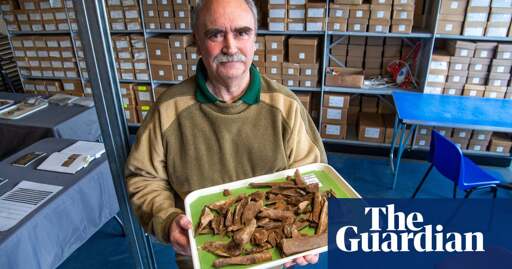cross-posted from: https://feddit.uk/post/26244752
Geography mattered on the Bloomberg site in the heart of the City, close to the Bank of England. The Walbrook, a lost river of London, had carved a deep valley into the landscape and the Romans constantly tried to reclaim the banks as the city grew and prospered. They did this by packing the ground with rubbish, building on it, then packing it again, three more times, so there is a stratigraphical layer cake of Roman trash going almost all the way back to London’s creation, in AD47 or 48. The river also waterlogged the ground, protecting the material from oxygen: leather, brooches, shoes, writing tablets, wood, animal bones and ceramics were all phenomenally well preserved. There are sandals that look fresher than last year’s Birkenstocks.
Site B2Y10 – to give it its academic name – was previously occupied by Legal and General, which dug deep in the 1950s, to create the biggest post-blitz rebuild in the City. Excavating archaeologists found the third-century Temple of Mithras, and oral histories from Londoners who witnessed the find in 1954 recall a magical atmosphere, when the secrets of the ancient past met the regeneration of the postwar present to create a sense of enormous hope and renewal. People queued for hours to see the temple. One woman who was pregnant at the time called her baby Mithra. As significant as that archaeological yield was, it was pretty haphazard – workers on the site were just picking things up and handing them in.
The Legal and General building had huge double basements, except on one side, where they had had to stay shallow for fear of jeopardising a Christopher Wren church on the opposite corner. “We were so excited by that single basement,” Jackson says. “We knew that in the layer underneath, that they hadn’t dug into, a lot of material would have survived.” Across 150 years of previous Roman recoveries in London, 19 writing tablets were found in total. In this one find, there were 400, of which 80 have already been deciphered. These are wooden frames, with an inset writing area about “the size of a Ryvita”, which would be filled with black wax, then written on.
…
Then there are anomalies that tell us something about the limits of Roman understanding. Jackson shows me a black, pebble-like object with three indentations on it, in which someone has tried to make a hole, to turn it into a pendant. Finding the material unnaturally unyielding, the Romans decided these were “solidified thunderbolts”, she says. “It’s so interesting to think of Romans doing archaeology themselves.” Not very well, mind; it wasn’t a solidified thunderbolt, it was a neolithic hand-axe made of obsidian.
It’s a reminder that we modern humans are also capable of misreading the signs. In the 1954 excavation, for example, they found beads that were assumed to have been worn by a woman, but here, those same beads and amulets were found still on their original strings, alongside other material that indicates they were worn by a horse. “It might have been a lady horse,” Marshall allows. Horses wore amulets covered in sexual imagery – such as fist-and-phallus amulets, with a clenched fist gesture at one end and an unmetaphorical phallus at the other, which was thought to ward off the evil eye. Children also wore amulets to ward off plague.


